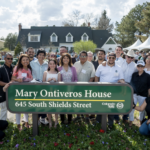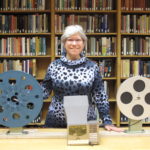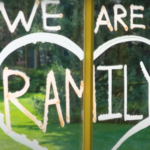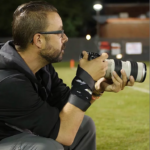By Angela Hayes, Ph.D.
What if virtual meetings could be wondrous places that we look forward to experiencing? We can look at the science of movies and TV shows to get us closer to having that experience with every well-run virtual meeting.
 Think about what happens in movies and TV shows. You might get Zoom fatigue within a few minutes and especially if you have a day of back-to-back Zoom meetings. However, you can binge watch 6 hours of a Netflix series with no fatigue and no problems. One reason is because of what happens in a movie or show that doesn’t happen on Zoom; there are cuts to different angles of the action about every 2.5 seconds. We are not built to stare at a screen where very little is moving and changing. Even something as simple as setting up your Zoom to flip between speaker view and gallery view can help. So you might do 2/3 speaker view and 1/3 gallery view. That way you listen to and see the speaker and then look at the gallery to gauge people’s reactions to what the speaker is saying.
Think about what happens in movies and TV shows. You might get Zoom fatigue within a few minutes and especially if you have a day of back-to-back Zoom meetings. However, you can binge watch 6 hours of a Netflix series with no fatigue and no problems. One reason is because of what happens in a movie or show that doesn’t happen on Zoom; there are cuts to different angles of the action about every 2.5 seconds. We are not built to stare at a screen where very little is moving and changing. Even something as simple as setting up your Zoom to flip between speaker view and gallery view can help. So you might do 2/3 speaker view and 1/3 gallery view. That way you listen to and see the speaker and then look at the gallery to gauge people’s reactions to what the speaker is saying.
A second thing that we can learn from movies and shows is that they have a story structure. Often the story arc is something like the story characters and a story problem gets introduced, then there’s action that leads to the climax and resolution of the problem (s). There are two properties of story structure that can help lead us to more engaging virtual meetings: curiosity and chunking.
Curiosity
Curiosity can hook us and keep us there. Bingeing on Netflix is a good example. You watch the first few minutes and you are hooked because you are dropped into the story’s problem, you get curious about it and you want to know what happens. Then you get hooked into the hint of what coming in the next episode, and you feel compelled to watch that and so on.
What if we could tap into that curiosity in our virtual meetings? One idea is to start your meeting with an unexpected statement or idea that compels others on the call to want to know more and possibly help “create the story” of what comes next. Another idea to tap into that natural curiosity and to create better, closer relationships with team members is by breaking them up into pairs and have them take a virtual road trip. You’ve probably noticed that you’ve often had really good, deep conversations on road trips. One of the pair can screen share a road trip from YouTube and the two can talk about what they are seeing and share curiosity about what’s coming next. This has the dual benefit of creating better relationships, which we know lead to better productivity/job satisfaction and allowing each member of your team to tap into their natural curiosity.
Chunking
Chunking is using our perception to divide continuous experiences into discrete parts. For example, movies help us chunk the visual and auditory signals we get and guide our attention. It could be a change to a wide angle shot to signify a new scene or a change in dramatic background music. In books, things are chunked into chapters.
Twists and turns in the story are also critical to getting our attention. That pulls us in. There’s an important balance needed though, if everything is a surprise, it’s overwhelming. If nothing is a surprise we tend to check out.
It’s very helpful for those leading the virtual meeting to chunk the information into discrete parts of the meeting in order to get and keep the teams’ attention, keep things interesting by adding in a few surprises and then chunk the main points of the meeting at the end. The final chunking in a meeting is very important. A good and clear ending is crucial to help us get a sense of what happened and helps us remember the main points covered.
Last, when planning virtual meetings, it’s extremely helpful to avoid a deficiency mindset and flip to a generative mindset. Instead of thinking what you can’t do virtually, think about what you can. For example, Zoom backgrounds could be used in practical ways. Meeting attendees could have a color of background that illustrates how they are feeling/thinking about what was just presented. They could have green for “I’m good, let’s move forward with it”, yellow is “I’m unsure about this and would like to hear more details”, and red could be “I have significant concerns I’d like to address”. This is likely to lead to a much richer discussion among those in the Zoom meeting, and can guard against the “checking out” that can often happen when those in the meeting are not expected/asked to be active participants.
Source: Rituals for Virtual Meetings: Creative Ways to Engage People and Strengthen Relationships by Kursat Ozenc and Glenn Fajardo

ANGELA HAYES serves as the Associate Director of Alumni and Online Career Engagement. Prior to coming to CSU, she worked as the Assistant Director of Alumni and Graduate Student Career Services at Kansas State University. She has a B.S. in psychology, an M.S. in industrial/organizational psychology and a Ph.D. in professional coaching and human development. She’s a nationally Board Certified Coach and a nationally Certified Health and Wellness Coach.
She has a passion for helping others to see their lives as full of possibilities and un-tapped potential. She views changes/transitions (both planned and unplanned) as opportunities for individuals to discover and plan out what they really want from their careers and lives.


































































